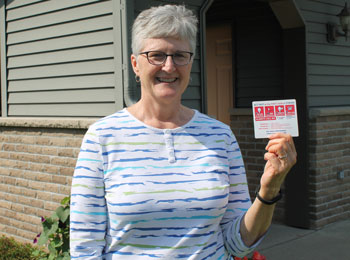Nancy's Story
Stroke Care“Nancy got help in time when she was having stroke because of a refrigerator magnet.”
Magnet reminded stroke patient to act FAST
Nancy Kjar, Paynesville, attended a Lunch and Learn program to learn more about strokes at CentraCare Health – Paynesville in June of 2016. She picked up a magnet that shows the indicators of a stroke event and placed it on her refrigerator. Two years later, this magnet assisted Nancy in making the decision to call for help.
After working outside in her yard, weeding and trimming, Nancy noticed that her left arm felt strange. She assumed it was from exhaustion and proceeded to the shower. She remembers looking at the clock when she came into the house at 5:40 p.m. While in the shower, Nancy dropped an earring and was not able to pick it up. She was still not “feeling right” while preparing supper when she noticed the ACT FAST magnet on her refrigerator. Nancy specifically noticed the “A” which stands for “Arms” and the sign of weakness in the arms. She remembers thinking, “Could this be happening to me?”
She decided to make a call to the Paynesville Hospital and spoke to a nurse. “The hospital wanted to dispatch an ambulance immediately. I was more worried about terrifying my neighbors with the lights and sirens, so I asked one of my neighbors to give me a ride to the Emergency Department, which is only a few blocks from my home.”
Upon arrival to the hospital just after 7 p.m., Nancy walked in and casually said, “I’m the person who called and might be having a stroke?” Nancy said four nurses and Dr. Larry Strate came rushing to her aid. Nancy continued to comment to her medical team that she was not sure if she really needed to be there. However, Dr. Strate assured her, “Oh yes. You should be here.”
After her stroke assessment, a TPA (tissue plasminogen activator) drug was administered and Nancy was on her way via ambulance to St. Cloud. “I still couldn’t believe what was happening to me. But, I could feel the TPA drug working in my arm.”
Because of her decision to get help quickly, Nancy’s stroke was not severe. She spent only two days in St. Cloud Hospital’s Stroke Center. Doctors discovered some blockage in the arteries behind her neck. Because surgical intervention in the neck/ spine area is higher risk, Nancy’s providers are monitoring and caring for her in non-surgical ways. She had a Loop Recorder implanted under her skin which constantly records the rhythm of her heartbeat to detect any signs of irregularity or atrial fibrillation. The recorder uploads the information to a portable monitor Nancy keeps by her bedside. If there are any signs of abnormal heart rhythm, Nancy’s doctors will know quickly.
“I don’t have to do anything. The information all transfers automatically to St. Cloud Hospital each night while I’m asleep,” said Nancy.
Nancy is again enjoying her normal life, only three months after her stroke event, with full functionality. She flew by herself to Seattle in August to visit her son and family. “I’ve been telling everyone what happened to me and about the importance of seeking help — fast,” said Nancy. “Because of my stroke, I know that I’m at a higher risk for possibly having another. But, I’m living my life and taking care of myself. I’m very impressed with the care I’ve received.”
Ischemic strokes are the most common type of stroke, accounting for 87 percent of all strokes. This happens when a clot blocks a vessel supplying blood to the brain. Many people miss the key brain-saving treatment through TPA because they don’t arrive to a hospital in time. The American Heart and Stroke Association reminds individuals to seek help immediately if any of these common stroke signs are happening:
- F = FACE: is one side of the face drooping or unable to smile?
- A = ARMS: Can both arms be raised or is one arm drifting downward?
- S = SPEECH: is speech slurred or sounding strange?
- T = TIME: CALL 911 immediately. The best outcomes for strokes are within the first four hours of initial symptoms.
